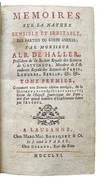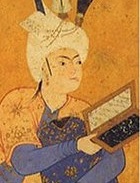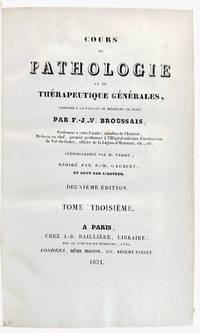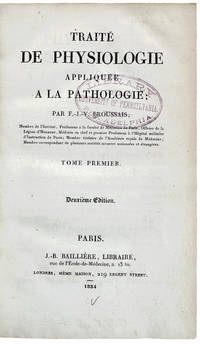Carousel content with 1 slides.
A carousel is a rotating set of images, rotation stops on keyboard focus on carousel tab controls or hovering the mouse pointer over images. Use the tabs or the previous and next buttons to change the displayed slide.
1756 · Lausanne :
by HALLER, Albrecht von (1708-1777).
Lausanne :: Marc-Mic. Bousquet, 1756; [vols. II-IV], Sigismond D'Arnay, 1760., 1756. 4 volumes bound in two. Thick 12mo. X, 399, [1]; [VI], 500; [2], 512; [4], XXIV, 232 pp. Titles printed in red & black, title vignettes. Engraved frontispiece depicting 3 vivisections, 2 engraved folding plates (vol. II, facing p. 432 showing the Achilles tendon; vol. III, facing p. 322 showing the intestine and colon; vol. IV with puncture from page 44-232. Modern full brown morocco, gilt-stamped spine, red morocco spine labels. Formerly from the collection of John G. Curtis (given to Columbia University, Dept. of Physiology), with bookplates showing his portrait. (truncated) Very good+. Second edition, corrected, of the French language edition, translated from the Latin by Samuel Auguste Tissot (1728-1797). Tissot was the "well-reputed Calvinist Protestant neurologist, physician, professor and Vatican adviser, Tissot practiced in the Swiss city of Lausanne. He wrote on the diseases of the poor, on masturbation, on the diseases of men of letters and of rich people, and nervous diseases." [Wikip.]. / Albrecht von Haller, the eminent Swiss anatomist and physiologist, wrote his dissertation at the age of 45, and on April 22nd and May 6th 1752, he read two papers before the Royal Society of Sciences of Goettingen. His thesis, De partibus corporis humani sensibilibus et irritabilibus, discusses the distinction between neural "sensibility", or perception (such as touch or pain), and muscular "irritability" (being the capacity of muscles to contract upon stimulation). / In the middle of the eighteenth century, this scientific debate involved some encyclopaedist physicians, Albrecht von Haller (1709–1777), Jean-Jacques Menuret de Chambaud (1733–1815), and Theophile de Bordeu (1722–1776). The doctor from Bern described irritability as an experimental property of the muscle fibers and made it the basis of a neo-mechanism in which organic reactions are related to the degree of irritation of the fibers. The practitioners from Montpellier considered sensibility, a property of living matter, to be a spontaneous activity of the organ and developed around this notion an original conception of the organism as the sum of the specific lives of each part. Beyond conceptual divergences, two ways of thinking whose philosophical presuppositions (conception of living matter, mechanism, and organicism), were in opposition, while their epistemological principles (experience versus observation) and their medical practices (active medicine and expectant medicine) went on to evolve in different directions. The privileged place granted to experimentation and assessment enabled physiology to be articulated as an autonomous scientific discipline; the pre-eminence of observation and attention to the radical specificity of the living being constituted the bases of clinical medicine. / See: Dominique Boury, "Irritability and Sensibility: Key Concepts in Assessing the Medical Doctrines of Haller and Bordeu," Science in Context, Volume 21, Issue 4, December 2008, pp. 521-35. [Abstract] / Haller's Concept and the European Controversy on Irritability and Sensibility, 1750-90 ... "Irritating Experiments Albrecht von Haller's treatise on irritability and sensibility, 1750-90." Hubert Steinke, 2005. "One of the great medical controversies of the Enlightenment was the European debate on motion, sensation, and animal experimentation provoked by Albrecht von Haller's treatise on irritability and sensibility (1752). Irritating Experiments is the first full-length study to explore the theoretical background and the experimental process that led to Haller's description and separation of two fundamental bodily qualities: irritability, or the capacity of muscles to contract upon stimulation, and sensibility, or the capacity of the nervous system to transmit impressions that are felt as touch or pain in humans, or produce signs of pain in animals. This new concept presented a serious challenge to the reigning medical systems. Haller's animal experiments were repeated all over Europe, on a scale never seen before. The results, however, were contradictory. Haller's concept was largely rejected, and animal experimentation could not be established as a major research method in physiology. Focusing on procedural aspects of experimentation, the interaction between experiment and theory, the status of surgery, the use of medical and pathological models, and the culture of criticism, Irritating Experiments tries to explain why." [Abstract]. / [Abstract] This paper will address the use of animal models as a vital constituent of 'life science in the making' by focusing on the 'sensibility trials' conducted by the Swiss physiologist Albrecht von Haller (1708-1777). Haller was a pioneering figure in the early days of neurophysiological research, being not only influential for establishing animal experimentation as a viable method to gain knowledge about (human) neurological functions. He also tackled the question of sensibility as the most fundamental property of living bodies, which came to influence our conception of bodily feeling. In analyzing some of his experiments on the nervous system, this paper addresses the following questions: what does sensibility or sensation signify in eighteenth-century physiology? How was it assessed or measured during experimentation? How were nervous functions 'read', i.e. how was the observable behavior of an experimental animal interpreted? And finally: how did Haller address the differences between humans and animals in the context of his investigations? – Stephanie Eichberg, "Constituting the human via the animal in eighteenth-century experimental neurophysiology: Albrecht von Haller's sensibility trials", Medizinhistorisches Journal, 2009. pp. 274-295. / PROVENANCE: John Green Curtis (1844-1913) "was one of the founding members of the American Physiological Society, and hosted its first meeting in his Columbia laboratory space." See: Garrison and Morton 587 [1752 first Latin edition.].
(Inventory #: M14859)







